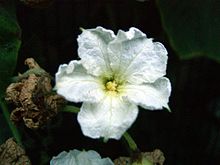 Just think—what is pumpkin, but a combination of excrutiatingly delicious orange pumpkin matter, and water. Water is water. It’s great. Stuff of life, 90% of the body, et cetera, et cetera. But it isn’t where the deliciousness lives. In fact, it mingles with the deliciousness of pumpkin flesh and—waters it down.
Just think—what is pumpkin, but a combination of excrutiatingly delicious orange pumpkin matter, and water. Water is water. It’s great. Stuff of life, 90% of the body, et cetera, et cetera. But it isn’t where the deliciousness lives. In fact, it mingles with the deliciousness of pumpkin flesh and—waters it down.
Who wants something that is watered down? No—one seeks the emphatic, the bold, the pure. Right?
So the trick to making delicious pumpkin and other winter squash is to remove the water. How to do that. Let’s see…there’s this thing that water does…I know, don’t tell me…it requires heat, but not center-of-the-sun heat…just normal, household-appliance-level heat…starts with ‘e’, ends with ‘e’…yes! It evaporates. Water evaporates when applied heat. Pumpkin flesh, on the other hand, does not.
Therein lies the secret. You’re welcome. Water just ups and leaves when things get hot enough. Pumpkin stays for the long haul.
Here’s what I’m trying to say. Imagine you roast a pumpkin (or other winter squash) so the flesh is easy to scoop off the peel. Then, you cook the pumpkin flesh in a pan for a good long time, stirring, stirring; till the steam rises and keeps rising and rising and eventually most of the water becomes the steam and leaves; and what you are left with is an increasingly pasty, gummy, reduced, deeply orange mass.
This takes only a couple ingredients to become one of India’s famed concoctions, to be had as dessert, or as a side with roti, or snuck in between meals from the fridge. Midnight snack? You wouldn’t dare? Done. Pumpkin halwa is great in all these ways.
Pumpkin halwa
Halwa is a general name for Indian desserts that are pastes. Sorry. What that description lacks in glamour it makes up in accuracy. It can be made of a number of widely disparate foods; wheat farina, whole wheat flour, carrot; and pumpkin. When I say ‘pumpkin’ of course I’m using it as a term of endearment for all winter squashes, those with the hard shell and sweet orange flesh. I used kabocha, which is known by foodies to out-pumpkin even the standard autumn pumpkins in terms of taste.
Made sweeter, it is a nice finish to a meal, served in tiny confection bowls; made a little less sweet, goes great as a side with deep-fried puffed breads, i.e. pooris.
Pumpkin halwa
Ingredients:
- One medium sized kabocha squash or sugar pumpkin
- 2 tablespoons ghee or butter
- Seeds of 6 green cardamoms
- 1 teaspoon sugar or to taste
- Pinch of salt
Method:
Preheat the oven to 425ºF. Slice the kabocha/pumpkin through the equator and scoop out the seeds with a sharp-sided spoon. I have found it really helps to pick a spoon that matches the curve of the hollow where the seeds are.
Lay the halves cut side down on a foil-lined cookie sheet along with 2 tablespoons water. Bake in oven for 45 minutes.
At that point the squash should be completely soft and easy to prick through with a knife. Bring them out and scoop out all the flesh.
Heat the ghee or butter in a non-stick, thick-bottomed pan. When melted, add the squash and cook on medium-high, mashing it down into the fat and stirring occasionally.
Meanwhile, grind the black inner seeds of the cardamom in a mortar and pestle.
In about 30 to 45 minutes, the flesh should be much drier and also look smoother, as the rough grain disappears with the water content. At this point, add a pinch of salt, the sugar, and the cardamom. Add more sugar after tasting if it is not sweet enough.
Garnish with ground pistachios, slivered almonds, roasted cashews, raisins or any combination.
(Click here to find me on Facebook and here on Twitter.)





























































